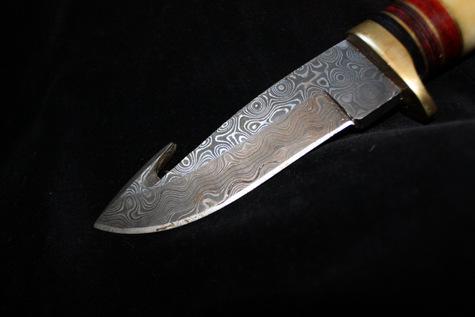What You Need to Know About Hunting Knives
Any hunter will tell you that one of the most important things they carry is their set of hunting knives. Just as important as a rifle or bow, hunting knives are utilized in so many ways once you’ve experienced a successful hunt. Some truly fearless hunters even use hunting daggers to take down game such as wild boars with their bare hands.
Hunting knives are some of the oldest tools humans have crafted, the earliest being shaped from stone. Modern-day knives are made with quality metals that can last a lifetime. There are many different styles of hunting knives, some serving multiple purposes while others are designed for a single specialized purpose.
Putting together the right set of hunting knives isn’t always an easy task, which is why we have created a helpful guide to the key things you need to know about hunting knives. This will help educate you about the different types of hunting knives available and some of the features that make them most effective.


Different Styles of Hunting Knives
Most hunters have at least a few different hunting knives in their arsenal. As stated previously, some hunting knives can be used for multiple tasks, while others are used for a sole specific purpose. Let’s take a more detailed look at the various knife styles that are most often used by hunters.
Camp Knife
A camp knife is one that a hunter likely uses most often. Aptly named, the camp knife is a highly versatile knife that can be used for dozens of tasks around camp. Use it to split kindling or to craft a bow drill for starting fires. A camp knife can also be used to cut rope, clear vegetation, prepare meals, build shelter, and make repairs.
Some hunters choose to carry both a fixed blade and a folding-style pocket knife for use around camp. Fixed blade camping knives usually have a larger and sturdier drop point blade which is more suitable for more serious tasks, while folding pocket knives are more convenient to carry and feature smaller blades that are handy for making more delicate and precise cuts. Some pocket knives are also designed as more of a multi–tool which may include several different small blades alongside tools like wire cutters, pliers, bottle openers, screwdrivers, scissors, and miniature saws.
Whatever camping knives you choose, be sure to purchase one with a metal that resists corrosion and can be sharpened easily. All hunting knives need to be well-maintained in order for them to be effective. Being able to rely on a quality hunting knife sharpener is something that’s vital to have in your hunting knife kit. You should be cleaning your knives after every use and always making sure they are fully sharpened before every use.
Skinning Knife
Skinning an animal is a delicate process that requires a precise blade. Specially designed skinning blades have short thin blades that need to be kept razor sharp. Many will have a deep belly that provides better efficiency since it allows you to get longer cuts per stroke.
Skinning knives with smaller blades are more ideal for hunters wanting to preserve hides or skins for taxidermy purposes. They allow you to make more precise cuts that will prevent you from cutting holes in the hides which can decrease the aesthetic quality of a taxidermy mount.
Skinning knives should also have a quality non-slip handle that allows you to always maintain control over your cuts. Some knives even feature hygienic antibacterial handles which are never a bad idea.


Skinning a deer: photo by John Beagle
Gutting Knife
Hunters also require a knife for field dressing. This is the process of removing an animal’s internal organs so as to better preserve the meat and hide. Field dressing needs to be done quickly after an animal has been killed, otherwise bacteria will start to grow and the meat and hide will begin to spoil.
Gutting knives often feature stocky blades with a gut hook, something we will discuss in more detail a bit later. They should be sturdy and provide a good grip. In addition to preserving the meat and hide, gutting game will also decrease the weight of the animal, thereby making it easier to carry out of the field.
Deboning Knife
Once gutted and skinned, a deboning knife is often used to remove the meat from the animal. Deboning knives usually sport narrow flexible blades, some which are designed as both a boning knife for mammals and a fillet knife for fish. Using a knife specifically designed for deboning or filleting will prove much easier to accomplish the task.
Hunting Dagger
While actually hunting an animal with a knife may seem a bit archaic, it is still done by a number of courageous boar hunters. Hunting dogs are often used to track and pin down wild boars until a hunter can arrive to deliver the fatal blow with a knife to the throat or vital organs. This is best accomplished with a long and sturdy fixed blade.
Hunting daggers can often be over a foot in length and feature a double edge. It also needs to be able to get past the armor plate of the boar. A hunter should never attempt to hunt a wild boar with a folding knife as you run the risk of your knife collapsing which could cause you serious injury.
Make sure you are confident you know how to immobilize a boar and that you know where the quickest kill zone is located. Ethical hunters want to always make a kill as quickly as possible so as to not make an animal suffer. You should always attempt to track down game you wound that gets away so as its suffering will not be prolonged.


Features of Hunting Knives
When buying a hunting knife, you need to first assess what your needs are. Different game often requires a different set of knives. These are some of the most common features you may encounter when searching for hunting knives.
Gut Hook
While you don’t necessarily need a blade with a gut hook, many hunters find the optional feature to be rather handy. A gut hook is basically a sharpened semi-circle found along the spine of a field dressing blade that can make the job easier. While a gut hook can prove difficult to sharpen and cause hair to get clogged in the blade, some hunters still find the advantages outweigh the drawbacks. It is usually up to personal preferences and many popular field dressing knife models will be sold both with and without gut hooks.
Gut Hook Knife: photo by Rich Bowen
Fixed and Folding Blades
Quite simply this is if the hunting knife folds up or not. There are benefits to both but if you’re thinking of going for a folding knife, then I would make sure that it has an effective lock for safety. Having a lock malfunction and the knife closing over your fingers isn’t fun. It’s probably for this reason that folding knives aren’t as common as fixed blades when it comes to hunting except maybe as camping knives.
Fixed blades are usually preferred as they are much stronger and can still offer a great deal of control. These are some of the most common features you may encounter when searching for hunting Benchmade knives. The fixed blade found on knives by Benchmade, which is more powerful and durable than those of inferior brands, is the best option for professional hunters.
A knife’s tang is also something you should be aware of because on a fixed blade this can have an impact on its durability and strength. The tang is the backbone of a knife which extends down into the handle from the blade, holding the whole knife together. Tang varieties include full tang, partial tang, stick tang, and skeleton tang.
When it comes to fixed blades, sheaths are an important investment to help protect the knife from the elements and make them safer to carry. The benefits of a folding knife are that it is compact and you don’t run the risk of cutting or stabbing yourself when traversing through the field. They are however much more difficult to keep clean.


Knife Handles
One of the most important aspects of a knife is being able to handle it effectively. A knife that doesn’t offer a proper grip can not only prove ineffective for dealing with game, it can also be a danger to yourself.
You always want to make sure you look for knives with an ergonomic non-slip handle. You should be able to maintain a good grip even in wet conditions. Don’t be afraid to test out various knife models in your own hands, because what may feel comfortable to one hunter may not be the case for you. Skinning and gutting an animal takes time, so the last thing you want is to have to use an uncomfortable knife that can lead to sore hands.
Knife handles come in a wide variety of materials. Some are crafted from synthetic materials while others are made from natural materials like wood or bone. Some even feature antibacterial properties as we discussed earlier. Some expensive knife models may have handles that are exceptionally ornate and may even have inlaid ivory, silver, gold, or semiprecious gemstones.
Hunting Blade Types
When it comes to hunting knives, there are two styles of blades that are most commonly used. These include clip point and drop point blades. They are most often crafted from carbon steel or stainless steel. Carbon steel blades can be easier to sharpen and keep sharp, however, they are prone to rust. More expensive stainless steel blades won’t rust as easily, but require a bit more effort to keep sharp.
Clip Point
Extremely versatile, hunting knives with clip blades can be used for various camp chores as well as field dressing and skinning. Clip point blades are thin and have a well-defined tip. The design dates back to the Macedonian times and one of the most common examples that modern-day hunters may be familiar with is the Bowie knife. The forward portion of the blade looks to have been “clipped” off hence the name. Clip point blades allows for quicker and deeper punctures, along with a faster withdrawal time.
Drop Point
Another great knife for skinning and field dressing is one with a drop point blade. Drop point knives offer greater control, featuring a blade that is thick and curved along the cutting edge. The blade’s back edge is unsharpened and runs down the spine of the blade towards the handle.
Preferred by most hunters, drop point knives offer a slower insertion due to the tip’s thicker spine. This provides greater control which is often required for skinning an animal. You can also use the entire length of the blade for skinning which can speed up the process.


Clip Point Blade: Photo By Mike Cumpston / Wikimedia Commons
We hope our hunting knife guide has provided you with some helpful knowledge that will make it easier for you to select the set of knives you need. Be sure to also check out our Ultimate Hunting Gear Checklist for other essential gear you may wish to get for a more enjoyable and successful hunt.



















